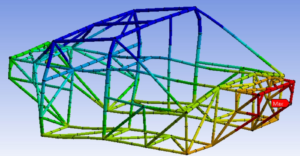
Throughout the history of engineering, people have always been testing things out; whether they’re a caveman clubbing a stick against a wall to see how stiff it is, or an automotive engineer testing the aerodynamics of a sports car in a wind tunnel. However, testing can be cost-prohibitive; industrial-sized wind tunnels cost hundreds of thousands of dollars, not including the models that need to be built for testing. So how does CalSol get the crucial physical and aerodynamic data needed to build safe and efficient solar vehicles? Our answers lie in ANSYS.
ANSYS includes several types of engineering simulation software. Its ability to integrate and analyze models from a multitude of design software such as SolidWorks allows us to examine how our experimental parts would perform on the road, without requiring us to make massive financial investments into physically testing every part ourselves.

Thanks to the generous support of ANSYS Inc., we have been granted full licenses to access their wide variety of analysis software. During the structural design of our latest vehicle, Tachyon, we decided to make the switch from a space-frame chassis to a monocoque design, where some or all of the load on the vehicle is supported by an external “shell.” This shell will be composed of crisscrossed layers of carbon fiber prepreg and aluminum honeycomb core, which are all lightweight and strong materials, but more difficult to analyze. Such a drastic change in design philosophy necessitated rigorous testing and analysis.

Dylan Callaway, a junior in Mechanical Engineering and our monocoque design lead, utilized ANSYS Composite Prep/Post (ACP) to design and verify the structural integrity of our vehicle. Whether we’re optimizing the aerodynamics of the newly designed top shell, or building shell panels for structural strength, our members can rely on ANSYS to provide us with the crucial analysis for a safe and streamlined shell.

For metal parts, we use ANSYS Structural to find how well they would hold under load. Using the variety of the FEA tools within ANSYS, CalSol members like Roger Isied, one of our chassis specialists, are able to conduct a wide range of crash deformation simulations without the pain and cost of building several physical models and testing them one by one.

Now, the fact that we’re able to analyze structural integrity with the help of the software from ANSYS is a massive leap compared to years past. But that’s not all: with ANSYS Fluent, their computational fluid dynamics (CFD) offering, we are able to simulate the aerodynamics of our vehicle. This allows us to optimize the efficiency of our solar vehicles, letting them drive with the lowest drag and resulting power consumption, and giving us a competitive edge.

Airflow modeling isn’t just used for our outer shell’s airflow. We are also able to model the airflow for other parts, such as tire rims, or cooling vents for both our battery packs and our driver. This modeling allows us to place our vents in the best positions to make sure we have enough air going into those critical areas while keeping drag low.

Without ANSYS, getting all this important technical data, whether material strength or ideal aerodynamics, would be grueling. We wish to express our gratitude to ANSYS Inc. for providing us with this valuable resource, and we look forward to a productive partnership for years to come.
Written by Eatone Cheng
